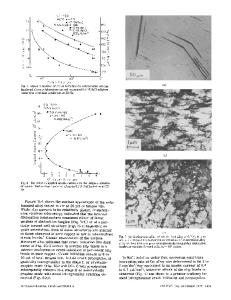Effect of Tensile Mean Strain on Fatigue Behavior of Al-Li Alloy 2099
- PDF / 962,799 Bytes
- 6 Pages / 593.972 x 792 pts Page_size
- 12 Downloads / 350 Views
JMEPEG https://doi.org/10.1007/s11665-020-04983-8
Effect of Tensile Mean Strain on Fatigue Behavior of Al-Li Alloy 2099 B.A. Rutherford, A.R. Cisko, P.G. Allison, and J.B. Jordon (Submitted December 17, 2019; in revised form June 24, 2020) In this study, the effect of tensile mean strain on the fatigue behavior of aluminum alloy 2099-T83 was experimentally examined for the first time. In order to elucidate the effect of tensile mean strain on fatigue lives, strain-control fatigue testing was conducted at three strain ratios (R = 2 1, 0.1, 0.7). Experimental results show that the application of greater mean strains during cyclic deformation resulted in shorter fatigue lives, particularly at lower strain amplitudes. At these lower strain amplitudes, the mean stress response to deformation did not fully relax as it did when subjected to larger strain amplitudes, where the effect of mean strains on fatigue performance was negligible. The Morrow and Smith–Watson–Topper mean strain correction models were implemented using monotonic and fully reversed fatigue properties in order to account for the damage associated with the relaxed mean stresses. A new model is presented that incorporates a mean stress sensitivity material property to capture, within a scatter band of three, the effects of tensile mean strains on the fatigue behavior of AA2099. Keywords
aluminum alloy, fatigue, mean strain, modeling
1. Introduction AA2099 is a third generation aluminum-lithium (Al-Li) alloy that is attractive to the aerospace industry due to the high specific strength associated with Al-Li alloys. Aluminum exhibits both a 3% reduction in density and 6% increase in elastic modulus for every 1 wt.% of lithium added (Ref 1). In addition to reduced weight and improved strength, AA2099 also possesses strong resistance to corrosion and greater resistance to fatigue crack growth than other high strength aluminum alloys. AA2099 may also become a viable material for design in industries such as the automotive sector as efforts are aimed at producing structures with lightweight materials. Some research into the fatigue behavior of 2000 series aluminum alloys has been reported in the literature. An increase in stress ratio, and by extension mean stress, in an Al-Li alloy was shown to reduce the fatigue threshold and increase the crack growth rate (Ref 2). Although the grain orientation and crystallographic texture have been shown to slow the rate of crack growth by increasing the crack path tortuosity through large elongated grain boundaries acting as barriers to crack growth (Ref 3), the effects of orientation and texture of the microstructure were observed to be negated by increasing stress ratios (Ref 2). Thus, a fatigue crack, when subjected to large tensile mean stresses in Al-Li alloys with highly textured and elongated grains, can readily overcome the barrier to growth B.A. Rutherford, P.G. Allison, and J.B. Jordon, Department of Mechanical Engineering, The University of Alabama, Tuscaloosa, AL 35487; and A.R. Cisko, Department of Mechanical
Data Loading...











